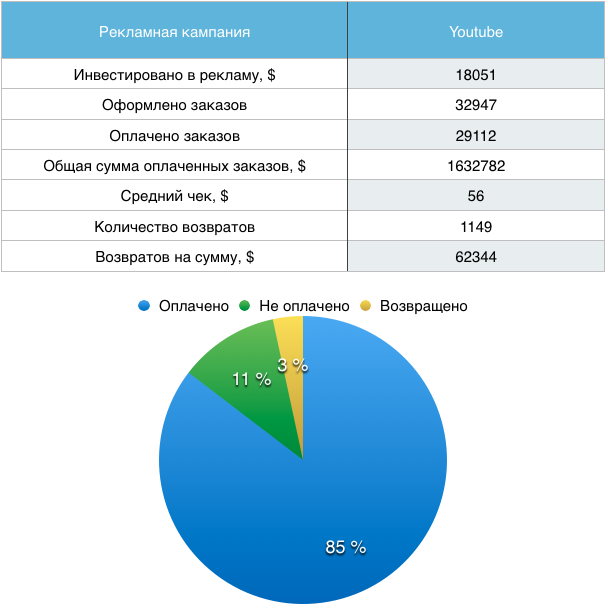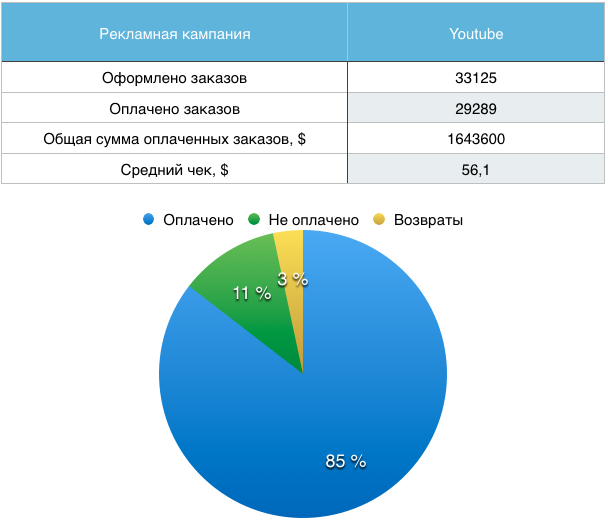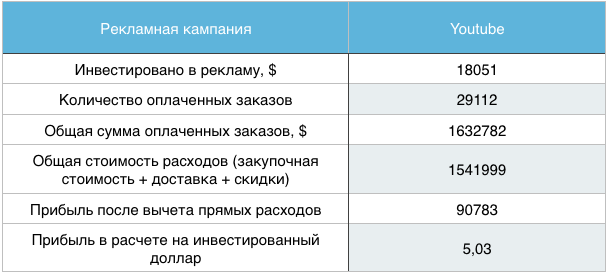We calculate the real effect of paid advertising on Youtube
The task is as follows: it is necessary to calculate the real effect of paid advertising on youtube. For this there is a customer - an online electronics retailer. After a two-week test period, a TrueView In-stream youtube campaign was conducted for three months. The daily budget after testing was $ 200. Over the period of 3 months, $ 18,051 was invested in the advertising campaign. For this money, Youtube showed paid advertising 584,780 times. In 118.650 cases, users reacted to advertisements, i.e. accidentally or deliberately transferred to the online retailer site.

Our task is to calculate the total interest from potential buyers, profitability and return on investment.
')
First, let's look at Google Analytics indicators for these 3 months on the youtube channel.
Here you can see that in fact for the specified period of time 99.826 new users moved to the site. If we divide the advertising budget by the number of visitors, we get the cost of attracting a new visitor to the site equal to $ 0.18. In terms of bounce rate, we see that a third of visitors, or rather 35.56%, left the site immediately. Statistically, the level below 40% is considered acceptable, from which it can be concluded that the overall content of the site is in the interests of visitors.

Next you need to decide on the basis of orders. By placing an order, we will understand the following situations:
In general, we use the attribution model last interaction. In this case, the results will be adjusted. Let us examine each case in order.
First of all, let us appreciate those who confirmed orders by switching from youtube from September 1 to December 1. Google Analytics shows that out of 99.826 visitors 32.947 finally moved to the order confirmation page.
But this is only confirmation. In practice, not all visitors pay orders. Some customers return purchases after payment. Unloading data on orders from CRM to the datawrapper, we see that out of 32,947 orders, only 29,112 were actually paid

Also need to consider returns. As can be seen from the table, 3.4% of orders were returned. Returned goods are sent back to the manufacturer \ distributor or go on sale at a discount.

Next, we will check which of the visitors went to the order confirmation page, but at the same time previously visited our site from other advertising channels. For this, we analyze conversion paths. It is convenient to do this by typing in youtube search or downloading statistics from Google Analytics to pdf and conducting a search on the document.
Here, for example, we see that the user placed an order but not immediately after switching from youtube. After that, he returned several times by going directly to the address in the browser string. Nevertheless, youtube was the last advertising channel and we can count this conversion as a result of youtube-advertising campaign.

Next, we look at CRM which of these clients made deals and for what amount. The user_id is used to identify the user between Google Analytics and RM. Correspondingly, we update the statistics and add 178 new orders. Of these, 177 were paid for a total of $ 10,818.

There are also visitors who wrote messages to live-chat, email and called the call-center. Subsequently, some of these visitors also went to the order confirmation page. Most often it was more convenient for users to communicate in live-chat.

In our case, all these orders are already taken into account in the statistics since you can place an order only by making a purchase on the site. Google Analytics in turn automatically maps the conversion to the referring source.
In some other types of business, the way of communication must be considered separately. If customers could place orders by email or call, you need to use call-tracking, email-tracking, etc. Past articles have already described customer identification in CRM and Google Analytics.
Dividing the amount of investment in advertising by the number of paid orders, we see that the cost of obtaining 1 paid order goes to the company at $ 0.62

Further, from the total amount of orders we successively deduct expenses. In some cases, this is not necessary, for example, if the goal is to acquaint the buyer with a new product. But there may be a situation in which sales will grow, and profits will not grow significantly. For example, if in an advertising channel, visitors predominantly ordering mainly low-priced goods or often returning purchases.
Costs divided into 2 categories:

After deducting direct expenses, profit was 5.56%. Based on the dollar invested in advertising, the online retailer received $ 5 in profits.
Further, the figures are compared with the figures for other advertising channels.

With further deeper analysis, you can evaluate the effectiveness of advertising for certain categories of goods or the feasibility of launching an advertising campaign for the sale of a particular product. In our case, the highest profits were obtained from the sale of gaming PC components and mining equipment. If the topic is interesting I will show a deeper analysis.

Our task is to calculate the total interest from potential buyers, profitability and return on investment.
')
First, let's look at Google Analytics indicators for these 3 months on the youtube channel.
Here you can see that in fact for the specified period of time 99.826 new users moved to the site. If we divide the advertising budget by the number of visitors, we get the cost of attracting a new visitor to the site equal to $ 0.18. In terms of bounce rate, we see that a third of visitors, or rather 35.56%, left the site immediately. Statistically, the level below 40% is considered acceptable, from which it can be concluded that the overall content of the site is in the interests of visitors.

Next you need to decide on the basis of orders. By placing an order, we will understand the following situations:
- Go to the order confirmation page, provided that the new visitor came from youtube from September 1 to December 1.
- Go to the order confirmation page provided that the visitor has previously visited the site, but the order was confirmed after the transition from youtube.
- The visitor wrote a message in the live-chat, email, or called the call-center and subsequently went to the order confirmation page.
In general, we use the attribution model last interaction. In this case, the results will be adjusted. Let us examine each case in order.
First of all, let us appreciate those who confirmed orders by switching from youtube from September 1 to December 1. Google Analytics shows that out of 99.826 visitors 32.947 finally moved to the order confirmation page.
But this is only confirmation. In practice, not all visitors pay orders. Some customers return purchases after payment. Unloading data on orders from CRM to the datawrapper, we see that out of 32,947 orders, only 29,112 were actually paid

Also need to consider returns. As can be seen from the table, 3.4% of orders were returned. Returned goods are sent back to the manufacturer \ distributor or go on sale at a discount.

Next, we will check which of the visitors went to the order confirmation page, but at the same time previously visited our site from other advertising channels. For this, we analyze conversion paths. It is convenient to do this by typing in youtube search or downloading statistics from Google Analytics to pdf and conducting a search on the document.
Here, for example, we see that the user placed an order but not immediately after switching from youtube. After that, he returned several times by going directly to the address in the browser string. Nevertheless, youtube was the last advertising channel and we can count this conversion as a result of youtube-advertising campaign.

Next, we look at CRM which of these clients made deals and for what amount. The user_id is used to identify the user between Google Analytics and RM. Correspondingly, we update the statistics and add 178 new orders. Of these, 177 were paid for a total of $ 10,818.

There are also visitors who wrote messages to live-chat, email and called the call-center. Subsequently, some of these visitors also went to the order confirmation page. Most often it was more convenient for users to communicate in live-chat.

In our case, all these orders are already taken into account in the statistics since you can place an order only by making a purchase on the site. Google Analytics in turn automatically maps the conversion to the referring source.
In some other types of business, the way of communication must be considered separately. If customers could place orders by email or call, you need to use call-tracking, email-tracking, etc. Past articles have already described customer identification in CRM and Google Analytics.
Dividing the amount of investment in advertising by the number of paid orders, we see that the cost of obtaining 1 paid order goes to the company at $ 0.62

Further, from the total amount of orders we successively deduct expenses. In some cases, this is not necessary, for example, if the goal is to acquaint the buyer with a new product. But there may be a situation in which sales will grow, and profits will not grow significantly. For example, if in an advertising channel, visitors predominantly ordering mainly low-priced goods or often returning purchases.
Costs divided into 2 categories:
- Direct - costs that are directly related to the goods sold. This is the cost of purchasing a unit of goods, the cost of delivery, a discount (if the goods are sold at a discount).
- Indirect - expenses that relate in general to running a business. For example, the cost of renting a warehouse, staff salaries, etc. In this analysis, these costs are not taken into account.

After deducting direct expenses, profit was 5.56%. Based on the dollar invested in advertising, the online retailer received $ 5 in profits.
Further, the figures are compared with the figures for other advertising channels.

With further deeper analysis, you can evaluate the effectiveness of advertising for certain categories of goods or the feasibility of launching an advertising campaign for the sale of a particular product. In our case, the highest profits were obtained from the sale of gaming PC components and mining equipment. If the topic is interesting I will show a deeper analysis.
Source: https://habr.com/ru/post/346834/
All Articles